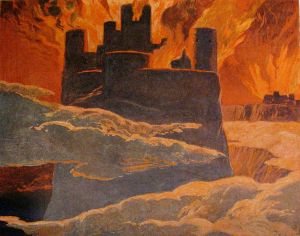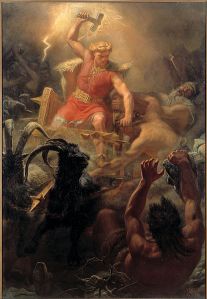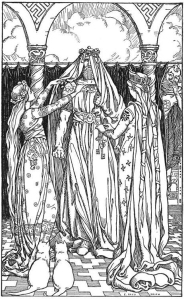I grew up with Edith Hamilton’s account in Mythology (1940/42) as my source on the Norse gods and their world. To judge from Hamilton’s account, the mythology portrayed a dreadful world in which the Norse gods struggled to survive, knowing they were doomed at Ragnarök. It seemed to me to be a humorless world developed by grim people.
So when I turned to the Eddas, I was pleasantly surprised to find out just how much humor they contained. The Vikings could laugh at their gods! And in doing so, they could laugh at themselves.
Take Thor, the best known Norse god, the wielder of the mighty hammer Mjöllnir. Ever hear the expression, “if all you’ve got is a hammer, everything looks like a nail?” Well, Thor has a hammer, so to him, everything looks like a nail. He instinctively reaches for his hammer to bash in someone’s skull any time he’s faced with a problem. Far from being the long-winded hero of Marvel comics, the mythological Thor is an amusing combination of masculine pride and limited intellect. It shows.
One Viking practice was to engage in flyting: a contest of exchanging insults in ritual fashion. One of the masters of flyting is Loki, the trickster figure of Norse mythology, born of a giant, but blood brother to Odin, chief of the gods. At one memorable feast, Loki takes on most of the Norse gods, insulting their courage, fighting ability, and sexuality. He’s fairly crude, but quite inventive. For example, he accuses Odin of letting the weaker side win in battle so his Valkyries can claim the braver men after they are slain. He accuses Frigg, Odin’s wife, of incestuous relations with Odin’s two brothers. Those are just a few of his accusations.
Thor isn’t present at the beginning, but comes in just about the time Loki brags about seducing the goddess Sif, Thor’s wife! Well, Thor isn’t going to take that lying down, so he calls Loki a homosexual (in terms that were specifically insulting in Viking culture) and threatens to kill him with Mjöllnir. Loki waxes creative, telling one embarrassing story about Thor after another. But all Thor can do is just repeat his initial insult and threat. He sounds like a broken record.
Oh, those embarrassing stories? For some reason, Loki skips what I think is the funniest one. One day, Thor wakes up to find his hammer gone. (It’s hard to ignore the Freudian implications.) It turns out a giant has stolen and hidden it. The giant won’t give it back unless Freyja, the goddess of love, marries him. So to recover his hammer, Thor has to impersonate Freyja by dressing up as a bride and pretending to marry the giant. As a bride, Thor is not a smashing success. He eats and drinks so much at the wedding feast that Loki has to apologize for him. Thor wears a veil to disguise his looks, but when the giant peeps beneath it, Thor is so enraged that his eyes glare in a distinctly unfeminine way. Thinking quickly, Loki again offers an apologetic explanation, saying “Freyja” hasn’t been able to sleep for eight nights thinking about her future husband.
The story ends as you might expect. Thor gets his hammer back, and proceeds to treat the giants like nails. His would-be husband dies. So do a lot of other giants.
Odin, as befits the chief god, is usually depicted as wiser. He sacrifices himself on Yggdrasil, the World Tree, to obtain the magical knowledge of runes. He gives an eye to drink from Mimir’s well to acquire wisdom. And he uses lies, trickery, and magic to seduce women all the time. Some wise leader! He brags about it, even. When he and Thor get into a flyting, Thor invariably talks about what he’s done fighting, while Odin prefers to relate his sexual conquests.
Now you might think, “Men!” And you’d be right. Male gods brag about their sex lives, while accusing females of being unfaithful or promiscuous. Just like real men have done.* And that’s the point. The Norse gods were all too human in character. And in laughing at them, the Vikings laughed at themselves. They could even admit, sometimes, that if women were fickle toward men, men were just as fickle and deceitful to women. After making these observations, the speaker in the Hávámál (one of the poems in the Elder Edda) sums it up by saying love makes fools of us all. Even Norse gods.
* No, that’s not an observation on contemporary politics. Leave it alone.





“Thor won’t give it back unless …” You mean the giant won’t give it back to Thor unless…?
LikeLiked by 1 person
Darn, last minute edit because I was using too many pronouns, and inserted the wrong noun. Thank you, corrected!
LikeLike
One of the best reviews of Norse mythology I’ve yet read. And a whole lot quicker than reading the Eddas. It might interest you/your readers to know that our word ‘bad’ comes from the Old Norse term for a homosexual. Says much of their attitude. As to projecting human qualities on to their gods, the Norse were not alone. It is standard practice (which is why I find mythology so interesting: for what it reveals). To wit, in the west we tend to project our idea of a father onto our Judaic-Christian god. In times past our daddy was a severe disciplinarian; now he’s all forgiving and full of love. Viva la Hippies!
LikeLiked by 1 person
Thank you. 🙂
I’d read the Prose Edda some time ago, but am still slogging through the Elder, which I expect to finish this month.
And American culture is such that the patriarchal stern Father is still much in evidence.
LikeLiked by 1 person
So glad I live in England!
LikeLiked by 1 person
And, btw, I did not know that derivation myself, so thanks for that, too!
LikeLike
Witnessing one of those flytings would have been absolutely hilarious, I think. I don’t think I’ve read anything much on the Norse gods. The Greek ones were always more my style. Hm. I may have to look into some mythology stuff again soon!
LikeLiked by 1 person
If you want to tackle the original texts, go for the Prose Edda, usually credited to Snorri Sturluson. Although the book is structured as a conversation between a king in disguise and three incarnations of Odin,it’s straightforward once you get the hang of it.
LikeLiked by 1 person
Pingback: Op zoek naar antwoorden op de vraag Is er een God # 1 Veel goden – Questiontime – Vragenuurtje